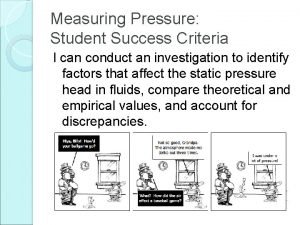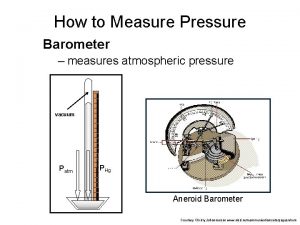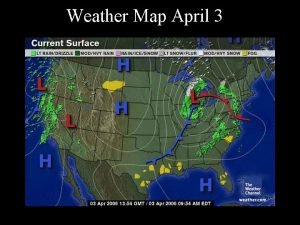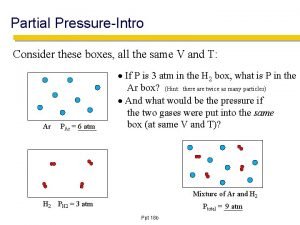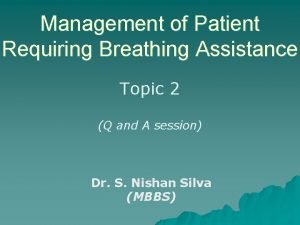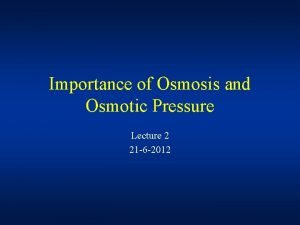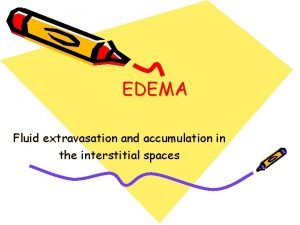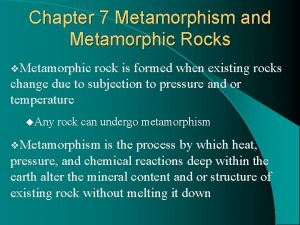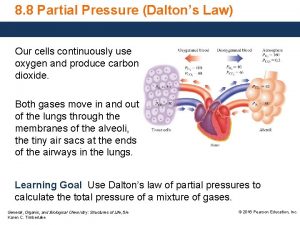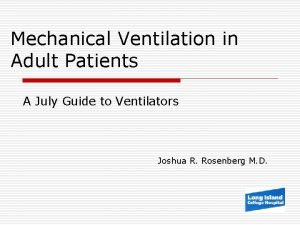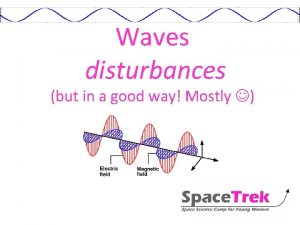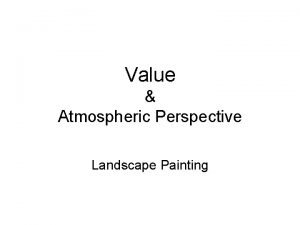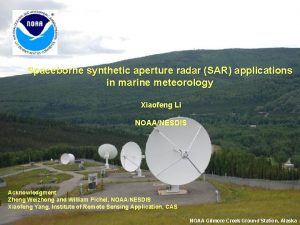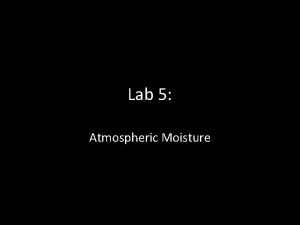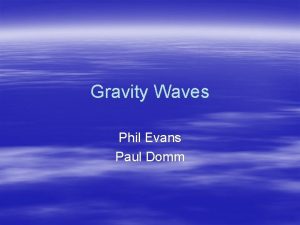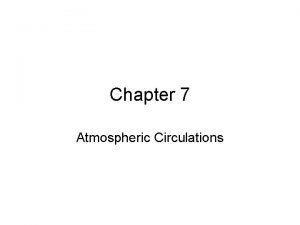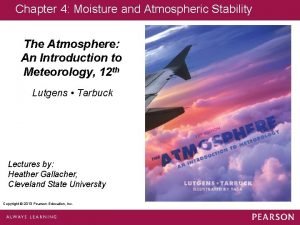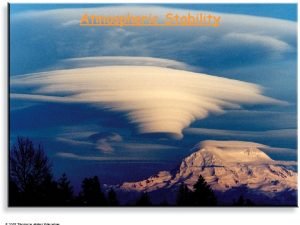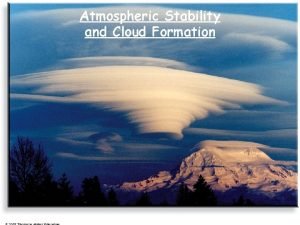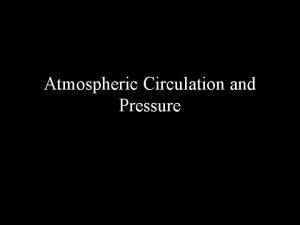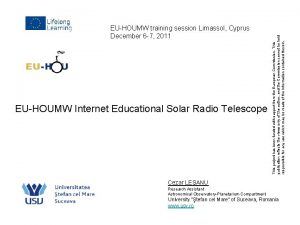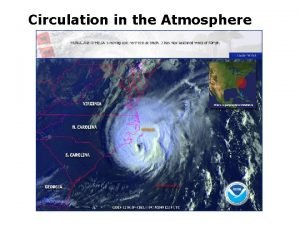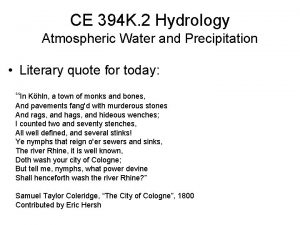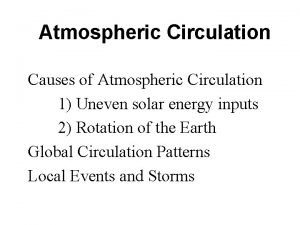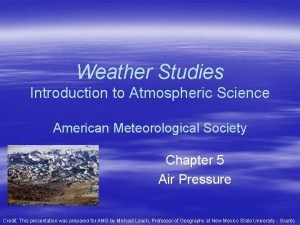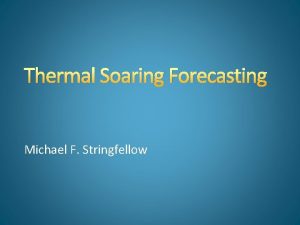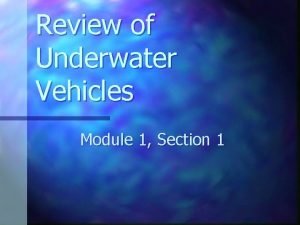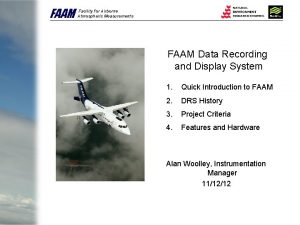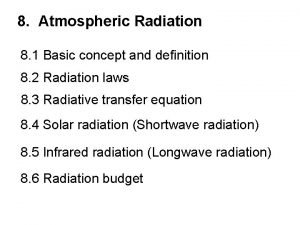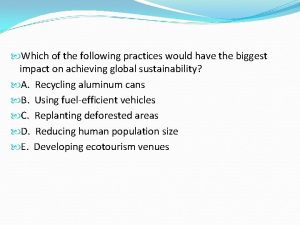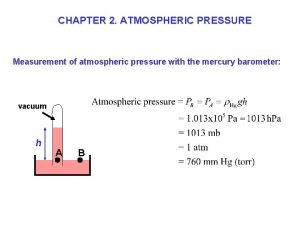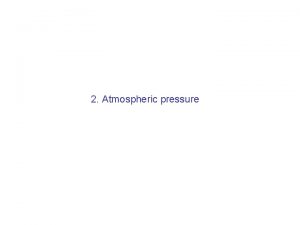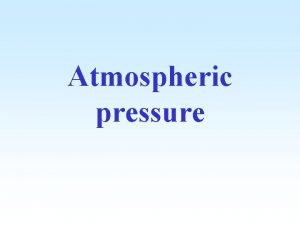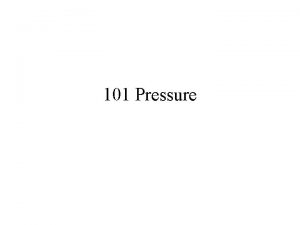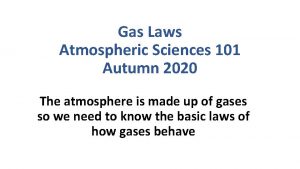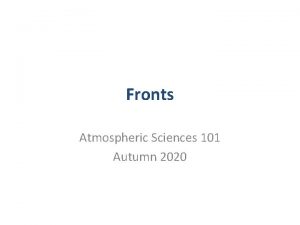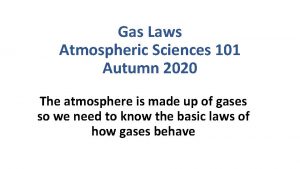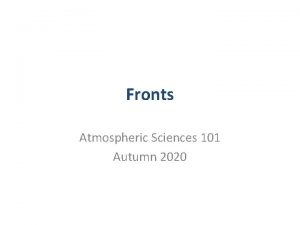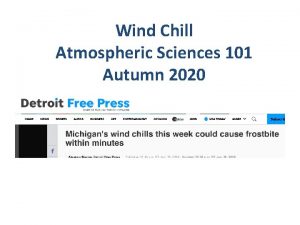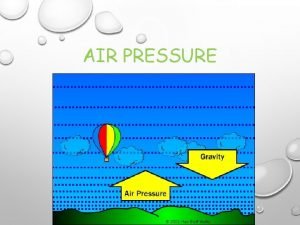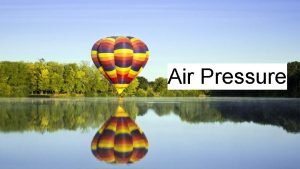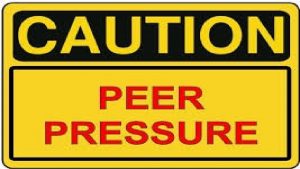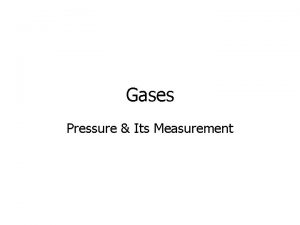101 Atmospheric Pressure Autumn 2020 What is atmospheric

























































- Slides: 57

101 Atmospheric Pressure Autumn 2020

What is atmospheric pressure? How is it measured? Why is it important?

o 0 K When T> (absolute zero), atoms and molecules are moving When they hit an object they provide a small push and thus apply a small force to the object

Convenient to talk in terms of pressure rather than forces Pressure = force area P = F A

Pressure is isotropic (independent of direction)

Atmospheric pressure is related to the weight of the atmosphere above the point in question So, is there atmospheric pressure under a table? ?

YES…because Pressure is isotropic

What about a tank of water with a hole in its side? Lower p Higher p A good illustration of isotropic nature of pressure

Pressure Units • Units of force per unit area • E. g. , pounds (lb) per square inch, newtons (N) per square meter. • So, a 150 lb man standing on shoes with an area of 30 in 2 puts a pressure on the floor of P= 150 lb/(30 in 2) = 5 lb in-2

Knowing about pressure can help you avoid this

Ski Example • Two cross country skis, each with area of 125 in 2 • Total area 250 in 2, 150 lb skier • P=F/A= 150 lb/250 in 2 or 3/5 lb in 2 • Skis result in less pressure! Less chance of sinking in snow!

Also the idea behind snowshoes

You don’t notice atmospheric pressure but it is there.

Collapsing Can Demo

Collapsing Can Collapsing Barrel Collapsing Tanker Car

Atmospheric pressure at any point is dependent on the weight of the air above that point W= weight of air in the column above the point P= F/A = W/A

Pressure decreases with height because there is less air above, so less weight P 3 P 1 > P 2 > P 3 P 2 P 1

Pressure Does NOT Decrease at the Same Rate with Elevation Falls off more rapidly near the surface

Why? Because the atmosphere is compressible and the density of air is greater near the surface

How does this fit with our discussion of pressure caused by the forces of molecules impacting on a surface? • Near the surface, air density is greater, so more molecules are available to impact a surface • The temperature is also warmer near the surface, so they are going faster. • The result: more pressure!


How do we measure pressure? With barometers. Three types: • Mercury • Aneroid • Electronic pressure sensor

Mercury Barometers • Invented by Evangelista Torricelli, a student of Galileo, around 1645 AD • To make one, you need a long tube around 40 inches long filled with mercury, and a dish of mercury

Mercury Barometer Why doesn’t the mercury all flow out of the tube? Atmospheric pressure!


Mercury Barometer • If atmospheric pressure increases, the height of the column of mercury increases, and vice versa • How high? At sea level, on average about 29. 92 inches or 76 cm (one inch=2. 54 cm) • So when a TV weatherperson says the pressure is 30. 06 inches…that is how tall a mercury column atmospheric pressure can support


Mercury is dangerous…

Why not use water in a barometer?

It would have to be roughly 30 ft tall! • Water is much less dense than mercury, so would need a much taller column of liquid to balance atmospheric pressure. • Related question: what is the size of the largest straw that would work?

Straws use atmospheric pressure to push liquid up the straw, thus the straw can’t pull water up more than 30 ft in elevation

Aneroid Barometer

No mercury, pressure changes the thickness of an air tight chamber/diaphragm


Barograph—another form of aneroid barometer


Barogram-plot of pressure in time

Altimeter: Aneroid Barometer Inside An altimeter is a device that uses pressure to provide elevation.

Solid State Pressure Sensor

Solid State Pressure Sensor The electrical properties of some materials are dependent on atmospheric pressure.

Smartphone Pressure Sensor


This app collects pressure

Back to Pressure Units • Remember P= F/A • So inches of mercury are not really units of pressure. • English units: lbs per square inch (psi). Average sea level pressure is 14. 7 lbs per inch 2. Car tires, 30 -35 psi. Bicycles 3580 psi • Meteorologists DON’T USE psi

Pressure Units • • Meteorologists use metric units. Newton is the unit of force in the metric system. Meter-squared is the unit of area. Pressure in metric units is 1 Newton per meter squared (N/m 2). 1 Nm-2 is called a Pascal. • Meteorologists frequently use hectopascals (h. Pa). h. Pa is 100 Pascals or 100 Nm-2 • Another favorite is millibar (mb), which is another name for hectopascals. (used more in past)


What is the pressure typically at sea level?

Sea level is considered zero elevation in meteorology • Mean sea level pressure=1013. 25 h. Pa= 1013. 25 millibars (mb) =14. 7 lbs in-2 • Same as 29. 92 inches of mercury or 76 cm of mercury or 760 mm of mercury • Meteorologists generally use h. Pa or mb for pressure.


Sea Level Pressure Variations

Surface weather maps plot sea level pressure-–the pressure at mean sea level (h. Pa or mb)


More on surface weather maps in a few days

Pressure in the vertical • Instead of using physical height (in meters or feet), meteorologists often use pressure • Pressure decreases with height – 1013 h. Pa – 850 h. Pa – 500 h. Pa – 250 h. Pa ~ 0 ft, 0 km ASL ~5000 ft, 1. 5 km ASL ~18, 000 ft, 5. 5 km ASL ~34, 000 ft, 10. 5 km ASL


Pressures Drop with Elevation • • Snoqualmie Pass ~ 900 h. Pa Top of Mount Rainier ~ 600 h. Pa Highest human settlement ~ 530 h. Pa Jet cruising altitude ~ 230 h. Pa (35 K ft)

The end
 Air pressure at different altitudes
Air pressure at different altitudes Pressure head meaning
Pressure head meaning Barometer vacuum
Barometer vacuum Low atmospheric pressure
Low atmospheric pressure Retention definition in prosthodontics
Retention definition in prosthodontics Mapline of atmospheric pressure
Mapline of atmospheric pressure Vmo advancement cpt
Vmo advancement cpt Pressure support vs pressure control
Pressure support vs pressure control Continuous bedside pressure mapping
Continuous bedside pressure mapping Intrapleural pressure
Intrapleural pressure Starling's equation
Starling's equation Partial pressure
Partial pressure Tripod position breathing
Tripod position breathing How are metamorphic rocks classified
How are metamorphic rocks classified Sore throat after surgery
Sore throat after surgery Bernoulli rule of integration
Bernoulli rule of integration Oncotic vs hydrostatic pressure
Oncotic vs hydrostatic pressure Hydrostatic pressure vs colloid osmotic pressure
Hydrostatic pressure vs colloid osmotic pressure Hydrostatic pressure and osmotic pressure
Hydrostatic pressure and osmotic pressure Oncotic pressure vs hydrostatic pressure
Oncotic pressure vs hydrostatic pressure Confining pressure vs directed pressure
Confining pressure vs directed pressure Regulation of blood pressure
Regulation of blood pressure How to find partical pressure
How to find partical pressure Vc+ vs prvc
Vc+ vs prvc Bevel of et tube
Bevel of et tube Atmospheric opacity
Atmospheric opacity Atmospheric perspective watercolor
Atmospheric perspective watercolor Atmospheric suits
Atmospheric suits Atmospheric gravity waves
Atmospheric gravity waves Penn state meteorologists
Penn state meteorologists Lab 5 atmospheric moisture
Lab 5 atmospheric moisture Atmospheric gravity waves
Atmospheric gravity waves Single cell model of atmospheric circulation
Single cell model of atmospheric circulation Atmospheric stability
Atmospheric stability Define unstable equilibrium
Define unstable equilibrium Conditionally unstable atmosphere
Conditionally unstable atmosphere Single cell model of atmospheric circulation
Single cell model of atmospheric circulation Atmospheric heaven
Atmospheric heaven The four main layers of the atmosphere
The four main layers of the atmosphere Atmospheric opacity
Atmospheric opacity Atmospheric circulation
Atmospheric circulation Atmospheric distortion correction
Atmospheric distortion correction What are weather variables
What are weather variables Atmosphere
Atmosphere Atmospheric convection
Atmospheric convection Dr. erukhimova
Dr. erukhimova Atmospheric convection
Atmospheric convection Atmospheric convection
Atmospheric convection Atmospheric convection
Atmospheric convection Weather studies introduction to atmospheric science
Weather studies introduction to atmospheric science Soaring index
Soaring index Atmospheric diving suit
Atmospheric diving suit Lightning elves
Lightning elves Facility for airborne atmospheric measurements
Facility for airborne atmospheric measurements Atmospheric refraction
Atmospheric refraction Atmospheric reaction
Atmospheric reaction Atmospheric
Atmospheric Traveling southward from the arctic regions of canada
Traveling southward from the arctic regions of canada

